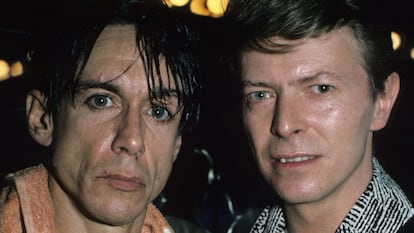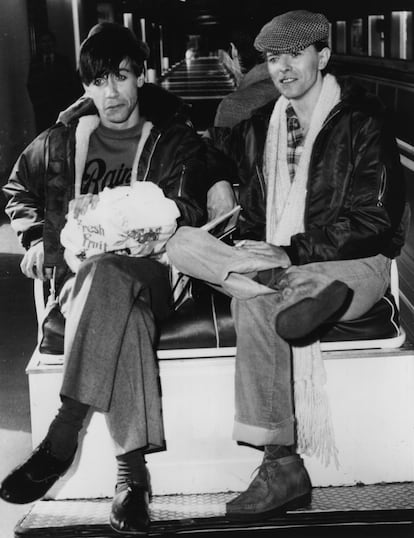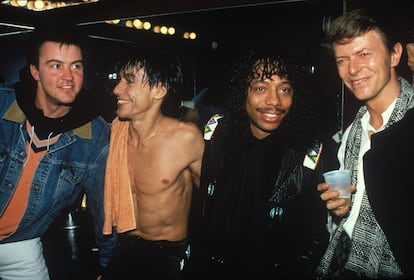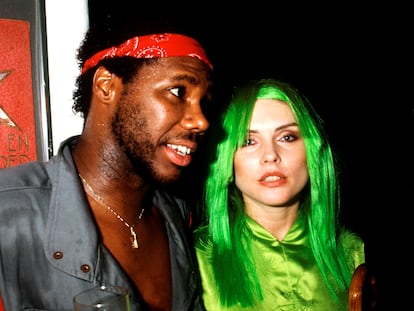When David Bowie ‘ruined’ Iggy Pop’s great album: A half century since rock’s most electrifying encounter
It was the century’s most memorable transatlantic transaction: the British glam star was tasked with channeling the performer languishing in American rock. Fifty years later, the album that resulted from that collaboration continues to mystify and captivate


Fifty years ago, in November 1973, the Stooges gave a concert at a university hall in Largo, Maryland, which Iggy Pop, now 76, considers the worst of his career. It was the most “murky, unhinged and narcotic” one. At that point, the Detroit band was “at war with their audience,” as Greil Marcus of the Doors used to say. Since the end of February, the band had been performing perhaps their best and undoubtedly their most controversial album Raw Power live. But even stalwarts like Californian critic Joel Selvin believed that the group barely had “an ember” of its previous stage fire left. They had lost their direction, energy and substance.
Not even adding the forceful and chaotic pianist Scott Thurston, and a second guitarist, Tornado Turner (who replaced Paul Williamson—for whom life on the road was beginning to seem unbearable—in some concerts), could rekindle the flame. Nevertheless, according to Selvin, they continued on a grueling tour that took them from Los Angeles to Cleveland, passing through Memphis, Phoenix, Toronto and Washington with little desire and even less success well into the winter of 1974.
After another couple of forgettable gigs in New York and Wayne, Michigan, they landed in their native Detroit on February 9. At this point the Asheton brothers, Ron and Scott, opted to pack up and stay home. Iggy disbanded the group four days later. It was the second time they split up. They would not play together again until November 2003.
Jim Jarmusch recounts the story of this struggle in his splendid documentary Gimme Danger, the hilarious epic of a band that was ahead of its time and suffered the consequences. Pop, the Ashetons and their first bandmate, Dave Alexander (who was expelled from the band in 1970 and died in 1975), had been trying to break into the rock scene since 1967. Following other Detroit groups, such as MC5, they anticipated the punk that would eventually crystallize in London in 1976.

Today, their first two albums, The Stooges (1969) and Fun House (1970), are considered masterpieces that contributed decisively to the American underground’s emergence, but at the time they garnered disappointing sales and were panned by most critics. Edmund O. Ward wrote in Rolling Stone that The Stooges was a “shrill, puerile, dull, unimaginative and tasteless” album.
A dish served raw
The fact is that Raw Power, an album that has grown in the popular imaginary for half a century now, was the direct consequence of a failure. In September 1971, Iggy Pop found himself without a band. His record company had decided not to renew the Stooges’ contract because it was producing meager results. The Ashetons were fed up with Iggy, his apathy and his sudden mood swings, which were fueled by his increasing heroin consumption.
Only his newest signing, Texan guitarist James Williamson, was willing to continue making music with Pop as soon as they received a new contract and formed a new band. However, that imminent return to work had been postponed repeatedly since the spring. Pop and Williamson were increasingly engrossed in narcotic inertia an spent their idle hours watching TV.

On September 9, David Bowie came to the rescue. John Adams, the manager of the remaining Stooges, called Iggy to tell him that the British musician was in New York having dinner at the famous Max’s Kansas nightclub with his partner, Tony DeFries, and wanted to meet him. Iggy nearly didn’t go. At the time, Bowie struck him as an opportunist and an upstart; besides, Pop was watching a Western film series. Crossing the couple of streets that separated him from the Park Avenue South nightclub seemed like an unappealing task. But Adams convinced him. And Bowie, a consummate flatterer, instantly won Pop over by telling him that the Stooges had been the best American band in recent years and suggesting that Pop travel to the UK to launch his solo career there, in an environment “more conducive to innovation.”
The Iguana in London
Pop took on the challenge. He signed a contract with MainMan, Bowie and DeFries’ label, and they landed him a deal with Columbia Records. Pop crossed the pond and settled in London, a city that seemed “unreal” to him, as he explained years later. He spent several months taking long walks through Hyde Park, Kensington and Westminster, waiting for DeFries and Columbia to decide what they wanted to do with him.
To overcome his creative block, he demanded Williamson’s presence in London; Pop considered him to be the only man who could help him write songs. Bowie had suggested the possibility of the two writing together but took the rejection gracefully: after all, he was too busy writing Ziggy Stardust. It took Iggy and Williamson forever to put together a handful of songs that met their own exacting standards, but by mid-1972 they were eager to get into the studio. MainMan suggested that the Detroiters recruit British musicians to complete a new band, but Iggy was not sure that he was interested in glam or in surrounding himself with Englishmen, whom he considered “the strangest creatures on the planet.”
None of the candidates for his new rhythm section lived up to Pop’s expectations. So, he called the Ashetons and asked them to fly to London to join a revamped version of the Stooges; Scott would be on drums and Ron would play bass instead of guitar, since Williamson—who had been loyal to the bandleader during times of crisis—had earned the right to be the band’s guitarist. As they would tell Jim Jarmusch years later, the Ashetons accepted because the months they spent at their parents’ house in the aftermath of the band’s first breakup had convinced them that they didn’t have anything better to do.
The return of the Stooges
Bowie, DeFries and Columbia were not thrilled by the Stooges’ untimely resurrection. Bowie went so far as to accuse Pop, whom he considered his protégé, of ingratitude and blindness: they had offered him a new opportunity and he had chosen to repeat past mistakes. After all, the Brit had not been entirely sincere in their meeting in New York a year earlier. He appreciated Iggy’s stage charisma and his ability to write energetic and fierce songs, but to him the Stooges seemed like a worn-out band and he thought the Ashetons were mediocre musicians with a rather deplorable image.

Nevertheless, they reached a gentleman’s agreement. The new band was to be called Iggy and the Stooges, the album would be recorded in London, at CBS studios, and a couple of ballads would be included with a string of proto-punk tunes that Pop and Williamson had conceived. Recorded with soundman Keith Hardwood at Olympic Studios, early demos set the tone, but Columbia was confident that the album’s sound, which was too raw and chaotic in their opinion, would be significantly polished under the supervision of one of their trusted men, Mike Ross-Trevor.
The album’s nine songs were recorded between September 10 and October 6, 1972. Pop says he felt like a kid on Christmas, regaining the feeling of making music with complete freedom and surrounded by his old mates, in a professional environment, backed by technicians who treated them with great deference and seemed to understand perfectly what the Stooges were all about.
The problem arose when Pop and Williamson insisted on acting as “producers,” even though they admitted they had “no idea” what they were doing. Specifically, they didn’t want the album to sound “glam or polished.” Even the album’s two backwoods ballads, “Gimme Danger” and “I Need Somebody,” were intended to have the Stooges’ signature tense, virulent sound.
As he later admitted, Iggy made an amateurish mistake by mixing most of the instrumental parts on one of the stereo channels and the vocals on the other, without much concern for minor issues like balance and tonal quality. Although the resulting mix horrified Columbia Records, Iggy and Williamson insisted that they wanted the album to sound this way.
DeFries stepped in to save the investment by deciding to have Bowie remix the tracks. In late October, the legend did so—apparently in a single day—at Western Sound Records studios. Iggy was there but did not have direct access to the mixing desk. Pop accepted this “humiliating” solution because he was given to understand that “there wouldn’t be an album otherwise.”

Despite everything, Bowie tried to be conciliatory and find a middle ground between Pop’s “artistic” concerns and commercial pressure from DeFries and the record company. Unfortunately, despite his good nature, Bowie was not an expert producer either and his work was rushed. Some experts attribute the (relative) failure of his involvement in the album to the use of technology like the Cooper Time Cube, which he found fascinating but with which he was unfamiliar.
Dude, what did you do to my album?
Iggy told Jarmusch that he “let [Bowie] do it,” but that his frustration grew as he noticed that the tracks had stopped sounding the way he had conceived them. He was particularly annoyed by Bowie’s insistence on emphasizing the percussion on songs like Penetration, trying to bring crispness and neatness to what Iggy wanted to sound “raw, chaotic and compact.”
Bowie’s version of events differs significantly. In the notes that accompanied the reissue of the album in 1996, the brit wrote that Iggy, not Tony DeFries, was the one who asked him to try to “rescue” an album that Columbia had already rejected because it suffered from obvious deficiencies. According to Bowie, his “very limited” intervention had just consisted of “details.” Iggy Pop believed that “Carrot Top” [a jocular reference to Bowie, whose hair was dyed orange in 1972] had “ruined” his album. Years later, on the occasion of that 1996 reissue, he qualified that very negative impression by acknowledging that “David did what he could, considering that the remix was done in a cheap studio and with a mixing board that looked prehistoric.”
Of course, in 1996 Iggy Pop had already been Bowie’s close friend for many years, a guardian angel who rescued him from a personal abyss in 1976 by taking him to East Berlin, where they lived together until 1978, and helping him to get off heroin and relaunching his recording career. Their legendary friendship even inspired the film Velvet Goldmine.
Moreover, the Pop of 1996 was no longer an artist lost in the labyrinth and anxious to find his place in the sun as soon as possible but rather a rock legend who felt at peace with his legacy. He could afford to be generous with the accomplice and friend who had contributed so much to it. As for Raw Power, despite the controversy surrounding its remix and the little faith that the label in charge of releasing it had in it, it was enthusiastically received, at least by the most modern and combative critics.
Today, we know that the album that nearly ended the incipient friendship between two titans of music and gave rise to a tedious and self-destructive tour is a marvel, the source to go to for evergreen classics of sound and fury like Search and Destroy and Gimme Danger. Time has proven him right and his reputation as a decisive cultural artifact is more than safe from the trivial controversies of 50 years ago.
Sign up for our weekly newsletter to get more English-language news coverage from EL PAÍS USA Edition
Tu suscripción se está usando en otro dispositivo
¿Quieres añadir otro usuario a tu suscripción?
Si continúas leyendo en este dispositivo, no se podrá leer en el otro.
FlechaTu suscripción se está usando en otro dispositivo y solo puedes acceder a EL PAÍS desde un dispositivo a la vez.
Si quieres compartir tu cuenta, cambia tu suscripción a la modalidad Premium, así podrás añadir otro usuario. Cada uno accederá con su propia cuenta de email, lo que os permitirá personalizar vuestra experiencia en EL PAÍS.
¿Tienes una suscripción de empresa? Accede aquí para contratar más cuentas.
En el caso de no saber quién está usando tu cuenta, te recomendamos cambiar tu contraseña aquí.
Si decides continuar compartiendo tu cuenta, este mensaje se mostrará en tu dispositivo y en el de la otra persona que está usando tu cuenta de forma indefinida, afectando a tu experiencia de lectura. Puedes consultar aquí los términos y condiciones de la suscripción digital.
More information
Archived In
Últimas noticias
Most viewed
- Reinhard Genzel, Nobel laureate in physics: ‘One-minute videos will never give you the truth’
- Oona Chaplin: ‘I told James Cameron that I was living in a treehouse and starting a permaculture project with a friend’
- Pablo Escobar’s hippos: A serious environmental problem, 40 years on
- Chevy Chase, the beloved comedian who was a monster off camera: ‘Not everyone hated him, just the people who’ve worked with him’
- Why we lost the habit of sleeping in two segments and how that changed our sense of time










































